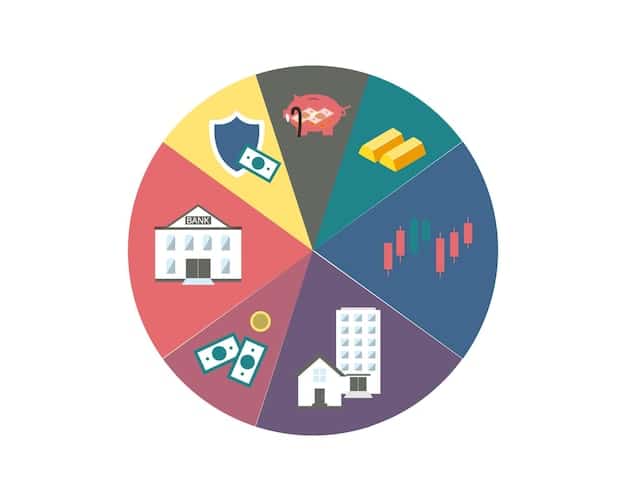Investing in Index Funds: Your Low-Cost Guide for 2025

Investing in index funds offers a diversified, low-cost strategy to track the market’s performance, making it an appealing option for both new and experienced investors looking to grow their wealth in 2025 and beyond.
Looking to make smart investment choices in 2025? Investing in index funds can be a simple and cost-effective way to tap into the market’s potential, offering diversification and long-term growth opportunities.
What are Index Funds and Why Invest in 2025?
Index funds are a type of mutual fund or exchange-traded fund (ETF) designed to mirror the performance of a specific market index, such as the S&P 500. This passive investment approach offers several advantages, especially when considering your investment strategy for 2025.
Understanding Index Fund Basics
Index funds aim to replicate the returns of a particular index by holding the same securities in the same proportions as the index. This differs from actively managed funds where a fund manager selects investments with the goal of outperforming the market.
Benefits of Investing in Index Funds
The appeal of index funds lies in their simplicity and cost-effectiveness. Because they don’t require extensive research and active management, index funds typically have lower expense ratios, meaning more of your investment dollars are working for you.
- Low Costs: Lower expense ratios than actively managed funds.
- Diversification: Instant exposure to a broad range of stocks or bonds.
- Transparency: Easy to understand what you’re investing in.
- Tax Efficiency: Lower turnover can lead to fewer capital gains taxes.
As we look ahead to 2025, the potential for market growth and the need for cost-conscious investing make index funds a compelling choice for building a solid financial future.
How Index Funds Work: A Simple Explanation
The mechanics behind index funds are straightforward. Understanding how they operate can give you greater confidence in your investment choices, especially as you plan for the financial landscape of 2025.
Replicating the Index
Index funds work by holding all or a representative sample of the securities that make up a specific index. The fund manager adjusts the portfolio as the index changes, maintaining the fund’s alignment with the index’s composition.
Passive Management
Unlike actively managed funds, index funds follow a passive investment strategy. This means the fund manager is not trying to pick winners or time the market, resulting in lower management fees and reduced trading activity.

By mirroring the index’s performance, index funds provide investors with a return that closely matches the overall market or a specific sector. This predictability and simplicity are key reasons why many investors choose index funds, particularly when planning for long-term financial goals in 2025.
Choosing the Right Index Fund for Your 2025 Goals
Selecting the right index fund requires careful consideration of your investment goals, risk tolerance, and time horizon. The variety of index funds available allows you to tailor your investments to your specific needs and preferences for 2025.
Assess Your Investment Goals
Before choosing an index fund, define your investment goals. Are you saving for retirement, a down payment on a home, or another long-term objective? Your goals will help determine the type of index fund that’s most suitable for you.
Consider your risk tolerance and time horizon. If you have a long time horizon and a higher risk tolerance, you may be comfortable investing in a stock index fund. If you’re more risk-averse or have a shorter time horizon, a bond index fund or a balanced index fund may be a better fit.
Types of Index Funds
There are various types of index funds that track different market segments. Here are a few examples:
- S&P 500 Index Funds: Track the performance of the 500 largest publicly traded companies in the United States.
- Total Stock Market Index Funds: Provide broad exposure to the entire U.S. stock market.
- International Stock Index Funds: Invest in stocks of companies located outside the United States.
- Bond Index Funds: Track the performance of a specific bond market, such as the U.S. Aggregate Bond Index.
By carefully evaluating your investment goals, risk tolerance, and the available options, you can select an index fund that aligns with your financial objectives for 2025 and beyond.
The Role of Index Funds in a Diversified Portfolio
Diversification is a cornerstone of prudent investing. Index funds can play a critical role in building a well-diversified portfolio, helping to mitigate risk and enhance long-term returns as you navigate the investment landscape in 2025.
Why Diversification Matters
Diversification involves spreading your investments across different asset classes, sectors, and geographic regions. This reduces the impact of any single investment on your overall portfolio, protecting you from significant losses if one investment performs poorly.
Index Funds as Diversification Tools
Index funds offer instant diversification because they hold a wide range of securities. By investing in an S&P 500 index fund, for example, you gain exposure to 500 of the largest U.S. companies, spreading your risk across various industries.

A well-diversified portfolio may include a mix of stock index funds, bond index funds, and other asset classes. The specific allocation will depend on your risk tolerance, investment goals, and time horizon for your financial plans in 2025.
Comparing Index Funds vs. Actively Managed Funds
The choice between index funds and actively managed funds is a fundamental decision for investors. Understanding the differences between these two approaches can help you determine which is best suited for your investment strategy in 2025.
Key Differences
The primary difference lies in the management approach. Index funds are passively managed, aiming to replicate the performance of an index, while actively managed funds seek to outperform the market through stock picking and market timing.
Cost Considerations
Actively managed funds typically have higher expense ratios than index funds due to the costs associated with research, analysis, and trading. These higher costs can eat into your returns over time, making index funds a more cost-effective option for many investors.
- Expense Ratios: Index funds generally have lower expense ratios.
- Trading Activity: Actively managed funds tend to have higher turnover.
- Potential for Outperformance: Actively managed funds have the potential to outperform the market, but this is not guaranteed.
In many cases, the lower costs and diversification benefits of index funds make them a compelling choice, particularly for long-term investors looking to build wealth in 2025 and beyond.
Strategies for Investing in Index Funds in 2025
To maximize the benefits of investing in index funds, it’s important to develop a sound investment strategy. Here are some strategies to consider as you plan for 2025.
Dollar-Cost Averaging
Dollar-cost averaging involves investing a fixed amount of money at regular intervals, regardless of market conditions. This strategy can help you avoid the risk of trying to time the market and can result in a lower average cost per share over time.
Rebalancing Your Portfolio
As your investments grow, your portfolio may drift away from your desired asset allocation. Rebalancing involves selling some assets and buying others to bring your portfolio back into alignment with your target allocation. This helps maintain your desired level of risk and can improve long-term returns.
For example, if your target allocation is 70% stocks and 30% bonds, and your stock holdings have grown to 80% of your portfolio, you would sell some stocks and buy bonds to restore the 70/30 allocation.
By implementing these strategies, you can enhance your investment outcomes and achieve your financial goals for 2025 and beyond through index fund investing.
| Key Point | Brief Description |
|---|---|
| 💰 Low Costs | Index funds have lower expense ratios compared to actively managed funds. |
| 📈 Diversification | They offer instant exposure to a broad range of stocks or bonds. |
| 🎯 Investment Goals | Align your index fund choices with your specific investment goals. |
| 🔄 Rebalancing | Regularly rebalance your portfolio to maintain your desired asset allocation. |
Frequently Asked Questions
▼
An expense ratio is the annual fee charged by a fund to cover its operating expenses, expressed as a percentage of the fund’s assets. Lower expense ratios are generally more favorable for investors.
▼
No, index funds are not risk-free. They are subject to market risk, which is the possibility that the value of your investments will decline due to overall market conditions or specific events.
▼
You can buy index funds through a brokerage account, a retirement account such as a 401(k) or IRA, or directly from the fund company. Research and compare different options to find the best fit for your needs.
▼
Dollar-cost averaging is an investment strategy where you invest a fixed amount of money at regular intervals, regardless of market conditions. This can help reduce risk and potentially improve long-term returns.
▼
The frequency of rebalancing depends on your personal preferences and investment goals, but a common approach is to rebalance annually or whenever your asset allocation deviates significantly from your target allocation.
Conclusion
Investing in index funds offers a strategic pathway to navigate the financial landscape of 2025 with confidence. By embracing their low-cost, diversified nature and aligning them with your financial goals, you can pave the way for long-term financial success.





